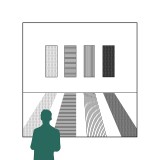Supervisor:
2018
Scale models are widespread as a means of representation and exhibition. But beyond this use, it has now evolved, creating the section of special scale models. The outgrowths of this section are the scale models that are used as a tool for lighting and sense of space studying.
In an era that architectural design sets aside the factor of the “user”, his satisfaction and his needs, this research study tries to throw attention to him. Is it possible to develop a user’s preference research system and on this basis to evaluate each project, by the user for the user? And if so, can this system be based on the use of a special model?
The present study research is trying to answer this query. In order to reach there, we first had to study in depth the different uses of scale models in the fields of architecture and representation ith examples from the 15th century to the present. It was then necessary to record and analyze the factors relating to natural lighting in workspace, as well as the usual systems that can be placed on the façade of such a space so that we can choose the samples to be given as options for the user. The third area that had to be studied in order for the experiment to be properly conducted, was how the scale models, that are used in lighting researches, are made so that accurate results could be produced and to resemble as much as possible, the representing space.
In order to test the usage of such a scale model as a user’s preference research system, we chose a typical office space as a subject for our fieldword, focusing on the façade. The reason behind that choice was that in such spaces, is common to apply various lighting and shading systems, but also because the contribution of natural lighting to user efficiency is very important. So we built a scale model with the following dimensions, 3x4x5 meters in scale 1 : 5 where the façade had the ability to be changed. We created three facades with different sizes of windows and six pattern representing corresponding shading systems and then we examined which of the choices was the most preferable to the users. The answers we were given, were compared to one another, in trying to see if some clear rates could be produced, for the research this would mean that the method we chose actually works and approximately that scale models can be actually exploited as a user preference research system.
